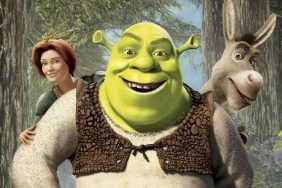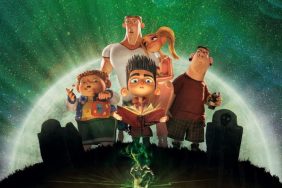
We all know that film is just a series of images played at 24 frames per second, giving those still images the illusions of movement. (Er… we all knew that, right?) But it didn’t take long for those mad filmmaking geniuses to realize that you didn’t have to capture those images in real time to make the gag work. You could draw those images, like they do in 2D animation, or you could even build models and move them just a teensy bit before capturing every frame. When you put those images together and play them back, that’s stop-motion animation.
It’s an eerie effect, an inanimate object moving of its own accord, and it’s been used time and time again to create realistic visual effects and also, when the filmmakers have the time (read: not very often), to animate an entire feature film like this weekend’s new release, The Boxtrolls.
Check Out: The Best Movie Ever: Kevin Smith
Stop-motion animation has been a part of a great many classic films over the years, but this is The Best Movie Ever. We’re only interested in the best! So we asked CraveOnline’s film critics – William Bibbiani, Witney Seibold, Fred Topel and Brian Formo – to come up with their picks for The Best Stop-Motion Animation Movie Ever. Find out which films they came up with, and why, and then scroll down to the bottom of the page to vote for your own personal favorites!
Witney Seibold:

I love stop-motion animation under just about any circumstances. Perhaps it was early viewings of “Gumby” or 2nd-grade exposure to “Mad Monster Party” that instilled a preference for the form, but I have always loved it. Even when it’s bad, there is a charm to animating with dolls or with clay that is irresistibly magical. Stop-motion – as it happens in front of you – tells the story of its own making. You can see every thumbprint, every frame, every slight movement, picturing in your mind the hard-working animator who had to position that little critter you behold cavorting. You can see every ounce of hard work that had to go into animating a scene.
And while Henry Selick, Tim Burton, and the folks at LAIKA are keeping the form alive, one cannot be a fan of stop-motion without knowing and loving the work of Ray Harryhausen, the special effects pioneer who brought stop-motion into feature films in a big way back in the 1960s. Harryhausen’s work is all uniformly impressive, but his best work was famously done in 1963’s Jason and the Argonauts, directed by Don Chaffey. The story, based on ancient Greek tales, is filtered through a broad, crisp, clear 1960s visual idiom, including the square-jawed pseudo-gay heroism intrinsic to the sword-and-sandal genre. Harryhausen brought several magical creatures to life for Jason and the Argonauts, including harpies, an enormous bronze warrior statue, and, most famously, a legion of fighting skeletons. The animation is smooth, gorgeous, and even a little scary. And it’s seamless.
However great modern special effects have become, they will never be as outright dazzling as what Ray Harryhausen accomplished decades ago.
Fred Topel:

Tim Burton dominated the semi-finals on this topic with his contribution to stop-motion feature films The Nightmare Before Christmas and Frankenweenie, but for me it was really between Beetlejuice and Paranorman. Paranorman is profound but time will tell how long it resonates.
Beetlejuice uses stop-motion animation to create an abstract afterlife that is the epitome of what we now describe as Burton-esque. It’s not heaven. It’s not hell. It’s just weird. Wild creatures roam the desert whenever ghosts Barbara and Adam Matland (Geena Davis and Alec Baldwin) try to leave their house. These are predominantly stop motion creatures.
The piece de resistance though is when the Matlands make the Deetzes dinner come to life and ends with an attack by Beetlejuice (Michael Keaton) himself in snake form. The stop motion effects are one of many tools in Burton’s chest to create his surreal afterlife and a wonderful example of how to use all techniques in harmony. But it’s so damn funny too, it’s a rare example of stop motion comedy.
William Bibbiani:

There are two ways to use stop-motion animation in a movie. The first is as a visual effect, a way to bring King Kong to life or that fantastic army of skeletons in Jason and the Argonauts. The second is to use it as a medium all its own, a painstaking process that nearly always seems to be worth the trouble. The quizzical horrors of Jan Svankmajer could not be possible without stop motion (he sometimes even uses the process on real, human actors); I would argue that Alice is his masterpiece but pick anything and you’re in for a treat. And Wes Anderson made what I think is his best film, Fantastic Mr. Fox, using stop-motion animation. I think it helped to emphasize my observation that Anderson, as a filmmaker, always treats his characters like mint-condition dolls in homemade dioramas anyway.
But the finest stop-motion animated movie is probably the most famous one: Tim Burton’s The Nightmare Before Christmas. Directed, ironically enough, by Henry Selick (although his name is on the title, Burton was too busy filming Batman Returns to be on set every day for Nightmare), the film is a grim storybook brought to life. It’s the tale of skeleton named Jack who unofficially runs Halloweentown, but when he hits burnout he latches onto the idea of Christmas, a holiday with a village all its own, ripe for the taking. Jack kidnaps Santa Claus, as kindly as possible, and tries to spread joy to the children of the world instead of scaring them half to death. Unfortunately for little kids, Jack’s interpretation of a merry Christmas comes with severed heads, killer toys and giant snakes. He can escape his day job, but not who he is.
Lots of movies – too many, if you ask me – are devoted to the simple moral that you should always be yourself. But The Nightmare Before Christmas does a remarkable job of capturing the glee of escapism as well as the perils of losing yourself in the process. It’s one of my favorite movies for that reason, and also for Danny Elfman’s catchy musical numbers, and for the lovable characters who populate its world. But that world of Tim Burton’s Nightmare would look goofy in live-action, and it would look too slick in CGI. It’s a film that couldn’t properly exist in any other medium except stop-motion. The tangibility of these warped characters and their oblong worlds gives The Nightmare Before Christmas an otherworldly quality that makes it real enough to believe in. Just what you want for a film about monsters, Santa Claus and unbridled imagination.
Brian Formo:

Having a baby means a lot of things — joy, pride, fear — but it also creates extra consumption. A baby grows fast and needs extra and new things all the time: clothes, chairs, utensils, etc. And its appetite grows. In Jan Svankmajer’s Little Otik this is presented as a horror because the baby is a tree root. It’s alternative title is “Greedy Guts.” And it’s the best stop-motion animation movie ever.
A couple (Veronika Zilkova and Jan Hartl) learn that they are unable to conceive a child. The husband finds an odd looking root in the back yard and cuts it to look like a grotesque baby. He thinks it’d be funny to present it to his wife, but of course we see this is a cruel joke and maybe we should be glad he’s not a parent. But she does take a shine to it. And begins to nurse it. And raise it. This wooden child has an immense appetite. The “parents” become increasingly delusional (there are no parents, this is nature!). A pedophile down the street notices that a child down the street is becoming less and less gender neutral. A dark, twisted, horror comedy ensues.
Svankmajer uses stop animation for the grotesque. He started with a number of stop-animation short films, including “Darkness Light Darkness“ where a body puts itself back together. His shorts introduced as an animator who possessed the surreal mind of Luis Buñuel. But Buñuel also had a deep concern for social classes, particularly after the fall of fascism. Svankmajer made Little Otik one decade after the Czech Republic had regained independence from the Soviet Union. Even though Otik begins using his sprouting roots similar to the tree in Sam Raimi’s Evil Dead, the underlying horror is in the child’s over-consumption and how much the parents (in this new society) are overcompensating by giving those greedy guts everything it wants.







